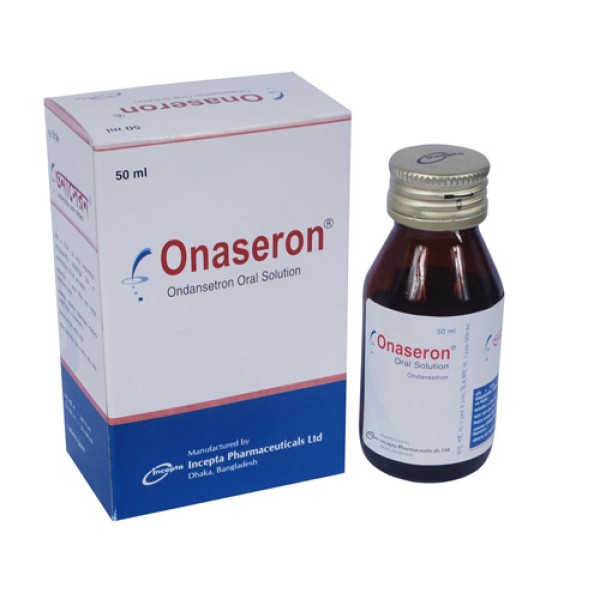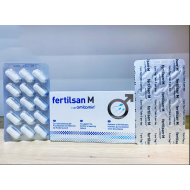
- Stock: In Stock
- Brand: Incepta Pharmaceuticals
- Product ID: Ondansetron
100% Secure Payment

This Item is for pre order
Onaseron Syp
Description
Ondansetron is a selective 5-HT3 receptor antagonist. While its mechanism of action has not been fully characterized, Ondansetron is not a dopamine-receptor antagonist. Serotonin receptors of the 5-HT3 type are present both peripherally on vagal nerve terminals and centrally in the chemoreceptor trigger zone of the area postrema. It is not certain whether Ondansetron's antiemetic action is mediated centrally, peripherally, or in both sites. However, cytotoxic chemotherapy appears to be associated with release of serotonin from the enterochromaffin cells of the small intestine.
Indications
1. Prevention of nausea and vomiting associated with highly emetogenic cancer chemotherapy, including Cisplatin >/= 50 mg/m2.
2. Prevention of nausea and vomiting associated with initial and repeat courses of moderately emetogenic cancer chemotherapy.
3. Prevention of nausea and vomiting associated with radiotherapy in patients receiving either total body irradiation, single high-dose fraction to the abdomen, or daily fractions to the abdomen.
4. Prevention of postoperative nausea and/or vomiting.
5. Nausea-vomiting associated with pregnancy
6. Nausea-vomiting associated with gastroenteritis
Dosage & Administration
1. Prevention of nausea-vomiting associated with chemotherapy
1 a. Adult
Parenteral: 32 mg single dose infused over 15 minutes by diluting with 50 ml saline (5% dextrose or 0.9% NaCl) 30 minutes before starting chemotherapy. Alternative therapy: Three dose of 0.15 mg/kg body weight. The first dose is infused over 15 minutes beginning 30 minutes before the starting chemotherapy. Subsequent doses (0.15 mg/kg) are administered 4 and 8 hours after the first dose of administration.
Oral: Highly emetogenic cancer chemotherapy: 24 mg (three 8 mg tablet) administered 30 minutes before start of emetogenic chemotherapy
Moderate emetogenic cancer chemotherapy: 8 mg (one 8 mg tablet) administered 30 minutes before start of emetogenic chemotherapy. A further 8 mg dose should be administered after 8 hours of the first dose. One 8 mg tablet should be administered twice a day (every 12 hours) for 1-2 days after completion of chemotherapy.
1 b. Pediatric
Parenteral (6 months onwards): Three dose of 0.15 mg/kg body weight. The first dose is infused over 15 minutes beginning 30 minutes before starting moderately to highly emetogenic chemotherapy. Subsequent doses (0.15 mg/kg) are administered 4 and 8 hours after the first dose of administration.
Oral (4-11 years): 4 mg tablet should be taken 30 minutes before the start of chemotherapy. The other 2 doses should be taken 4 and 8 hours after the first dose. Then 4 mg tablet should be administered 3 times a day (every 8 hours) for 1-2 days after completion of chemotherapy.
2. Prevention of nausea-vomiting associated with radiotherapy
Adults/ Geriatric/ Child of 12 years or over
The recommended dose is 8 mg tablet 3 times a day.
For total body irradiation: One 8 mg tablet should be administered 1 to 2 hours before each fraction of radiotherapy administered each day.
For single high-dose fraction radiotherapy to the abdomen: One 8 mg tablet should be administered 1 to 2 hours before radiotherapy, with subsequent doses every 8 hours after the first dose for 1 to 2 days after completion of radiotherapy.
For daily fractionated radiotherapy to the abdomen: One 8 mg tablet should be administered 1 to 2 hours before radiotherapy, with subsequent doses every 8 hours after the first dose for each day.
3. Prevention of post-operative nausea-vomiting
3 a. Adults/ Geriatric/ Child of 12 years or over
Parenteral : Undiluted 4 mg intravenously or intramuscularly immediately before induction of anesthesia. The rate of administration should not be less than 30 seconds, preferably over 2 to 5 minutes. Alternatively, the dose can be administered post-operatively if the patient experiences nausea and/or vomiting shortly after surgery
Oral: 16 mg (two 8 mg tablets) 1 hour before induction of anesthesia.
3 b. Pediatric (1 months to12 years)
Parenteral : Weighing less than 40 kg: 0.1-mg/kg body weight in a Single dose . Weighing more than 40 kg: 4mg single dose The dose should be immediately before induction of anesthesia. The rate of administration should not be less than 30 seconds, preferably over 2 to 5 minutes.
Alternatively, the dose can be administered post-operatively if the patient experiences nausea and/or vomiting shortly after surgery.
4. Nausea-vomiting in gastroenteritis
4 a. Adult: 8 mg three times daily.
4 b. Pediatric (1 month or over): 0.15 mg/kg body weight three times daily.
5. Nausea vomiting in pregnancy
8 mg (1 tablet) 2-3 times daily
Onaseron ODT administration procedure:
Onaseron ODT should be removed from the blister gently. Then it should be immediately placed on top of the tongue where it will dissolve in seconds and swallowed with saliva. Administration with liquid is not necessary.
Side Effects
Generally Ondansetron is well tolerated. However few side effects including headache, diarrhoea, fatigue, dizziness and constipation may be seen after Ondansetron is administered.
Precautions
Ondansetron is not a drug that stimulates gastric or intestinal peristalsis. It should not be used instead of nasogastric suction. The use of Ondansetron in patients following abdominal surgery or in patients with chemotherapy-induced nausea and vomiting may mask a progressive ileus and/or gastric distension.
Use in Pregnancy & Lactation
Pregnancy: Pregnancy category B.
Nursing mother: It is not known whether Ondansetron is excreted in human milk. Because many drugs are excreted in human milk, caution should be exercised when Ondansetron is administered to a nursing woman.
Drug Interaction
The following drugs should be used with caution when concomitantly used with Ondansetron:
Phenytoin, Carbamazepine, Rifampicin & Tramadol.
Over Dose
There is no specific antidote for Ondansetron overdose. Hypotension (and faintness) occurred in a patient that took 48 mg of Ondansetron tablets.


























%20Pvt.%20Ltd./Movicol-Oral-Powder-190x190.jpg)
